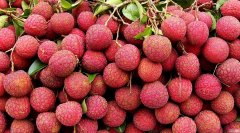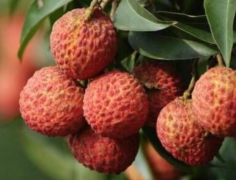March red litchi management techniques, planting methods, March red litchi pruning techniques, pest control
March red litchi tree trunk smooth grayish brown, branches stout, sparse, wood crisp. The leaf surface is smooth, leathery, the surface is dark green, the new shoot is dark reddish brown. The flower spike is thick and short, and the ear branch is reddish brown. The fruit is oval or crooked heart-shaped, the pericarp is dark red, thick and crisp, the fruit spine is flat, the average fruit weight is 26.6 grams, the flesh is white and translucent, the flesh is thick and tough, and the juice is less. The seeds weigh 1.8 grams and belong to large nuclear species, but if they are mixed with other varieties (such as jade purse), some of the seeds can also be found to be small nuclei. The tip of the large seed will be slightly wrinkled, which is characteristic of the March red variety. In addition, the pulp of the fruit is a little more, and there is often a brown leathery film near the seed, and the pedicel (navel eye) is large. The sugar content can reach 16-17 OBrix, and it is sweet and slightly sour when ripe.
Cultivation and management
First, climate and soil
Litchi is a subtropical fruit tree, and the temperature is too low to be suitable for production. Therefore, it is cultivated in the south of Hsinchu, and the soil should choose loam or sandy loam with good drainage. The pH value is slightly acidic to neutral. If it is rich in organic matter, it will contribute to the root development and absorption capacity of March Red Litchi.
Second, planting period, mode and density
Litchi propagation is mostly in the way of high pressure, and March Red is no exception, but because the survival rate is lower than other varieties, only about 60-70%, so high pressure, it is appropriate to use aquatic plants to wrap, and then add rooting agent to improve the success rate of striping. Avoid planting in the high temperature period in summer and plant at a distance of 4 ~ 5 meters. After transplanting, in order to avoid that the root has not yet regained its absorptive capacity, the first shoot pruning leaves two pairs of leaves at the base, and the second shoot leaves four pairs of leaves. The third shoot is left to grow naturally.
Third, pruning
March red litchi plants grow slowly, and the height of ten-year-old trees is only 3.5 meters. After pruning to the next flowering, there are only two shoots on average, so March red is not suitable for heavy pruning, otherwise it will affect next year's flowering.
Fourth, fertilizer and water management
The application of fertilizer is similar to that of other litchi varieties, mostly used to supplement the gift fertilizer after fruit harvest, and then add organic fertilizer and chemical fertilizer when heading and flowering. It should be noted that when foliar fertilization, the concentration of fertilizer should be reduced, and it must be sprayed evenly, otherwise it is easy to cause fertilizer injury and yellowing of leaves. For water supplement, except for keeping the soil dry from autumn to before heading, the soil should be kept moist in other periods so as not to affect plant growth and fruit development.
Fifth, pest control
(1) Litchi rust ticks: cut off diseased branches and diseased fruits, burn them centrally or spray them at the initial stage of new shoots with 800-1200 times of Baofu water suspension or 300 times of wettable sulfur powder.
(2) litchi moth: remove the withered branches, fallen leaves and fruits in the garden to avoid adult spawning; about 20 days after falling flowers, apply 80-1200 times of Jiaofushui suspended powder or 1000 times of fentazone emulsion or 1000 times of prednisone emulsion, once every 10 days, 3-4 times in a row, and stop application 10 days before harvest.
(3) litchi glue worm: the parasitic branches of litchi were cut off and burned. In the peak period, prednisone emulsion or prednisone emulsion was applied 1000 times, once every 10-14 days, 2-3 times in a row.
(4) litchi dew blight: avoid the fruit bearing place too close to the ground, before the rainy season, use 33.5% Suidening water suspension 2000 times or zinc and manganese water suspension 2000 times to prevent the occurrence of the initial source of infection.

- Prev

When will Guiwei litchi mature and come on the market? Guiwei litchi is an early-maturing variety or a late-maturing variety
Guiwei litchi, have you ever eaten this variety of litchi? When is the best time to eat this kind of litchi? What breed do you belong to? Let's have a look! ★ tastes the best taste of litchi from July to August, which is also the ripening period of litchi, and the meat is fresh and fresh.
- Next

What are the characteristics of new varieties of litchi, jade litchi and crispy litchi? what are the planting points?
What are the characteristics of crispy litchi? The crisp litchi is easy to bloom, with a moderate number of flowers, high and stable yield, and the fruit ripens in the middle and last ten days of June. In terms of appearance, the fruit of this variety is medium-large, heart-shaped, reddish with yellow pericarp, flat shoulder, round top, crisp pulp and wax white.
Related
- A course of planting techniques and methods on how to grow carrots
- How to plant the latest tulips?
- Is it better to pick tea in the morning or in the afternoon? When is the best time for tea to be picked? what is the third or fifth tea?
- Launch Yuanxiao Happy combination Haocha + Tea Yuan healthy Taste
- Penghu Tourism "Fireworks 20 Parade with You"
- 2022 West Lake Happiness holds "Digital Revitalization Voucher" and draws iphone13 and laptop.
- Banqiao Fuzhou social houses are designed to change start-up combined with police elimination to create a safe and livable environment
- The convenient measure of "mechanical weeding" in Xinbei has been abused and the Agriculture Bureau has imposed heavy penalties on the illegal land consolidation.
- Changgeng University Joins Hands with Four Memory Factories to Rescue Memory Talent Shortage
- The list of Taiwan's top 100 MVP managers is listed by the Director-General of the Farmers' Association of Sanxia District.

